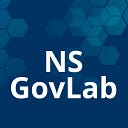NS GovLab, in partnership with the Mi’kmaw Native Friendship Centre, gathers fellows from across Nova Scotia for a year long fellowship experience focused on the questions:
How might we create a province where people can age at home and stay connected to their community?
How might we foster connections across generations and cultures to create resilient communities in Nova Scotia that can adapt to their changing demographics?
The fellows gather information related to ageing well, make sense of the information, develop prototypes based on their research, and test their prototypes in community. This immersion experience was the first of many opportunities for the fellows to learn more about their communities.
I have been interested in indigenous culture and wanted to attend the gatherings I heard or read about, yet I never have. I admit I worried about feeling uncomfortable for many reasons. Would I really be welcome? Would I be seen as an interloper? Would I look like a white person acting out of tokenism?
We share such a troubled past and I feel guilt about this and feel helpless to do anything concrete about it. I have studied and read about indigenous cultures but what practical and personal actions could I, as an individual, take?
I have never known an indigenous person with whom to share my concerns, so I did not follow up on the opportunities that presented themselves — until meeting Debbie Eisan through NS GovLab and attending the Mawita’jik at the Zatzman Sportsplex in Dartmouth, Nova Scotia on June 22, 2019.
From the minute I entered the Sportsplex, and throughout my time there, I felt a bit like a child — curious, on edge in a good way — absorbing, feeling all that surrounded me. The drums, the chanting, the movement, the colour, the joy, the pride filled the huge building.
Before the Grand Entry, there was the young boys’ dance. The dancers were wonderful, so alive and filled with joy. Many were dressed in colourful and dramatic regalia that captured the eyes of those watching yet I was drawn to one young boy. He wore no regalia other than a cloth vest. He danced with incredible concentration on the drumming, his face serious as his feet moved with the driving rhythm. It was if the drums and chanting were part of who he was and as vital to him as his heart and lungs.
Later during the Grand Entry, it was a very elderly man that drew my attention. He walked a little to the side of the main group, using his cane to steady his steps. Like the little boy who danced so seriously earlier, he was engrossed in the beat of the drums, moving stiffly but at one with the throb of the drums.
These two dancers, one aged and one young, captured my attention and my heart. In them, I saw the physical and spiritual connection of the individual to the drums, chants and dance. I was in awe of the resilience of a people who had suffered so much and yet somehow had held on to the roots of who they were.
I remain awed, I remain humbled, I remain hopeful.
Immersion Experience
Research in an immersion location challenges the researcher. This is especially true when a large public event is involved. Mawita’jik was busy, colourful, and a completely new experience for me personally. I decided before I went that I would just let it happen, observe with curiosity, and not think too much, not analyze (I too often resort to this when facing a new experience. It keeps me from being overwhelmed with discomfort or emotion). I was determined to just let it happen all around me.
And I did! It was an awesome — literally awesome — experience. I was surprised by the emotion I felt and was reminded of the NS GovLab principle, ‘learning over knowing’. To learn one must be open, curious, and thoughtful and I found myself wondering about so much. I was curious about not only what I saw but the how of this type of gathering came to be; the role it plays in the lives of the people involved; how this experience informs behaviour/attitudes of individuals after the event; how important the sense of community, of belonging must be… some many questions!
There were people of all ages at the gathering from a nursing baby to elderly marchers and dancers. It was wonderful to see this because too often events seem to be attended by specific demographic (an example is the annual tea at our community hall — almost everyone is over 60, with some middle aged adults, a few young adults, and even fewer children). To see all ages participating and engaged was a wonderful thing.
This immersion experience was the first I had undertaken, and I found it challenging. Because I tried to be open to the experience, I was rather overwhelmed and unfocused so I feel I did not get as much out of it as I should. I could have prepared more but then I would have expectations/assumptions based on that prior knowledge and that could change my whole experience. That is probably why NS GovLab encourages more than one immersion experience — one can get better at it!
For me, this immersion experience was enriching from both a personal perspective and from that as someone who wanted to gain deeper insight into the many layers of ageing populations.
